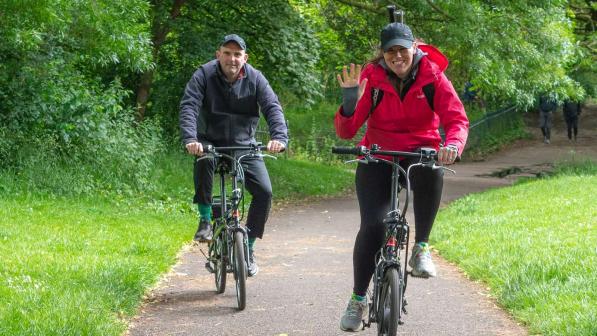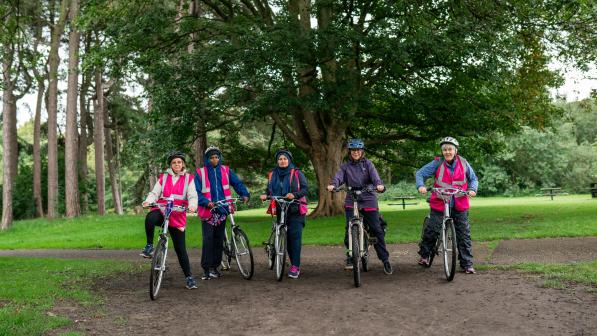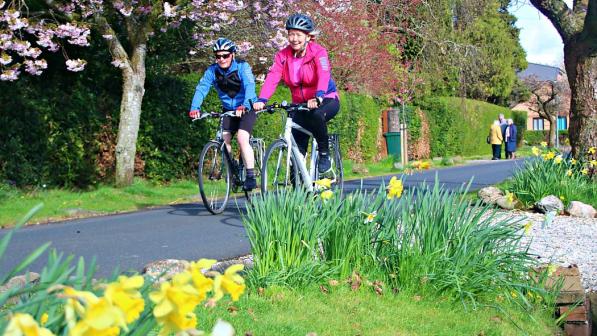10 ways to … help other people to cycle

1. Help them choose the right kind of bike and equipment
To the ‘layperson’, most bikes are more or less the same; they might come in different sizes and colours, but otherwise there’s not much to choose between them. So why not just go for the cheapest?
But, as regular cyclists, we know that certain bikes are more suitable than others for different people, purposes and budgets – especially as they can cost more than people think for one that’s light, strong and reliable, unless you can find a secondhand bargain (there are more of these around these days for various reasons).
How to choose the right model can be very confusing with so many available but our guide to the most common types is a very good starting point. If they want to use the bike for shopping, the school run, commuting or other utility reasons, it’s important to find a safe way of carrying any extra luggage or passengers too and security is also crucial.

2. Help them feel comfortable on the bike
Above all, the bike must be comfortable, otherwise it will join the many others languishing unloved in sheds around the UK. Many people are put off cycling because they’ve never had a bike that’s the right size or fit or a saddle that suits their requirements.
They might think – possibly because of negative media coverage – that riding a bike is always difficult and exhausting. This doesn’t have to be true – it might simply be a case of being shown how to pump the tyres up properly, adjust the saddle to the right height and position and use the brakes and gears with ease. Brake levers and handlebars can also be adjusted by people who are confident mechanics.
I absolutely love my ebike – it’s like floating on air and helps me overcome my mobility issues. I’m so glad I discovered cycling now walking is difficult for me
Tracy, ebike rider, pictured above
Our guide to choosing the right bike size is invaluable for making sure they are not riding a bike that’s too big or too small. A proper bike fit is well worth considering for optimum comfort and efficiency. Other top tips include with their legs extended, putting the ball of the foot on the pedal and not gripping the handlebars or brakes too tightly.
3. Become a cycle ‘buddy’
Probably the easiest way to encourage friends to cycle is simply by showing them a few things they may not know about cycling. It’s surprising how things we take for granted, such as having fully inflated tyres or knowing a quiet route, may not be so obvious to acquaintances who haven’t cycled for years or who have never ridden a bike very far.
Even better, go on a ride with them on a favourite, quiet route to show them how enjoyable it can be. Many people don’t think they’ll like cycling simply because they've never tried it.
They have possibly heard only negative stories so think it’s far more dangerous than it actually is. They may even be unaware of the many quiet lanes and off-road routes that make cycling such a pleasure, thinking it’s always a case of trying to avoid being knocked off by a motorist.

4. Get trained
If you want to give advice on things like road positioning, signalling and negotiating junctions, it’s a really good idea to get qualified as a National Standard instructor. Even if you’ve been riding for years and feel pretty confident on a bike, you may be surprised by some of the helpful tips you can pick up.
The government-sponsored scheme is described as: “The skills and understanding needed to cycle safely and responsibly, and to enable others to cycle.”
The training has three levels and is suitable for anybody from total beginners to those who have cycled thousands of miles.
Cycling UK can also offer training to groups in ride leading for clubs both on and off road.
5. Volunteer for your local cycling group
Local groups are best placed to encourage people to take up cycling. There will often be people with years of experience who can point out the best places to ride and tell you about local routes.
Members will have be able to pass on a wealth of knowledge and tips about everything from the best clothing for the elements, to tweaks you can make to your bike to improve its performance and much else besides – including the best places for coffee and cake!
Groups are almost always looking for more volunteers. Find a club near you and get in touch to see if they need more ride leaders, help with events or tasks that can be done from home, such as editing the newsletter, posting on social media, or being the treasurer.

6. Start your own group
If the local group isn’t putting on the kinds of rides you like, or you can’t find one close by, why not consider setting up your own? You can create a group from scratch, choosing a location, target group, name, logo and style of cycling that suits you best.
The group could even be formed around colleagues or friends from other hobbies and interests, as long as they are interested in starting or returning to cycling.
7. Volunteer at local recycling centre or community cycle club
Cycling UK has many projects all over the UK which are centred on behaviour change and reaching communities who may not normally be active as cyclists or walkers, for example those without access to a bike or who have been prescribed exercise for their physical or mental health.
Many of these projects are interested in taking on volunteers to help lead rides, fix or prepare bikes, lend a hand at events or in many other ways. Check out the latest opportunities on our Volunteer Hub.

8. Become an advocate for cycling
The more of us who speak up for cycling, the better it will be for all of us. This could either be formally, through our Cycle Advocacy Network, where local campaigners come together to share ideas, tips and information for how to make the world better by bike, or informally as a micro volunteer for Cycling UK, spreading the word about the work we do.
Whatever your contribution, you will be doing your bit to help us improve conditions for people who cycle everywhere – and encourage more people to get on their bikes.
9. Fight falsehood with facts
Some people will mention the negatives as soon as the word ‘cycling’ is mentioned. We’ve all had those discussions about all the perceived wrongdoings of cyclists, the jokes about Lycra and the old clichés about road tax.
Sometimes it’s hard to get a word in edgeways but, if you do, our Ten common questions and answers about cycling will give you plenty of ammunition to counteract these views.
10. Be a good role model for cycling
Perhaps the most important way to encourage other people to cycle is to show them what fun it is – and how it can benefit their lives in so many different ways. From saving time and money to helping the environment to providing exercise, friendship and adventure the list of positives about cycling is endless.
By showing and telling how much you benefit from having it in your life, you’ll be the best advert there is for encouraging other people to give it a go!



